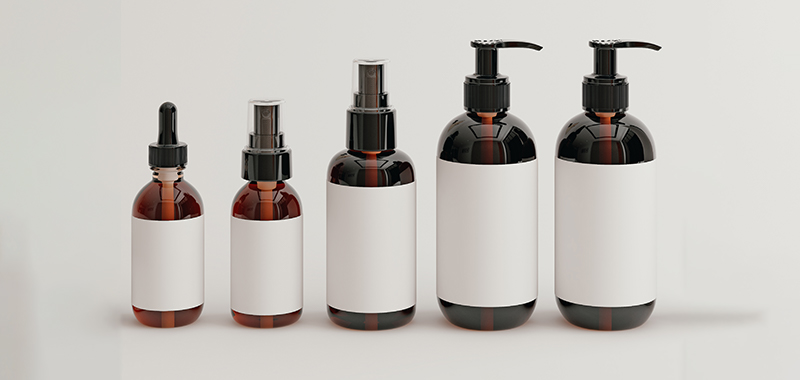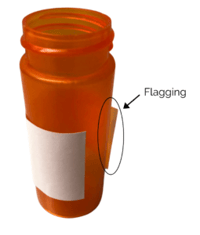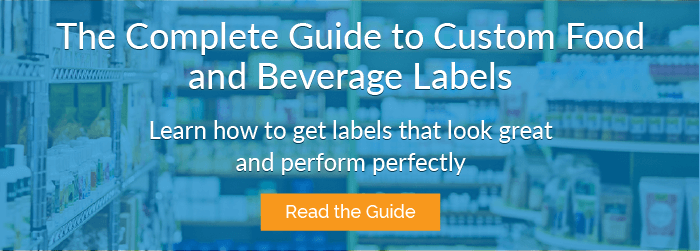
It may seem silly to sing the praises of a piece of packaging, but bottles allow us to enjoy some of our favorite products.
From craft beer to condiments to cosmetics, bottles make it convenient to use, store, share, display, buy, and sell the products we swear by. And bottles don’t just help with the fun stuff: They protect us from dangerous chemicals and keep our medications safe.
Despite all they do for us, however, bottles do have a few oddities that must be addressed when choosing labels and label materials.
Most bottles are rounded, and often with sloping sides and curves. Plus, their surfaces are often shiny and slick. These issues (and more, which we’ll discuss below) mean that a cheap and cheerful sticker just won’t do when choosing the best labels for glass bottles or the best labels for plastic bottles.
A knowledgeable and experienced custom label printer understands that every bottle is different, if not in design, then in purpose. Your printer will lead you through a series of questions that will help them determine the best label material, adhesive, and label shape for your brand’s glass or plastic bottle. The result? A label that looks great and performs the way you need it to.
Here are some of the questions you can expect:
What Kind of Surface Are We Working With?
From a design and usability standpoint, there are pros and cons to choosing glass bottles over plastic or vice-versa.
For example, glass (the traditional favorite for wine and spirits) imparts an air of upscale quality. Plastic is squeezable, which helps customers get the last drop of their favorite barbecue sauce. (And we should note that “plastic” is a broad category of materials with widely different properties — as you know from looking at the recycling numbers on the bottom of your plastic containers at home.)
The good news? No matter what type of bottle you decided works best for your product, an experienced custom label company will work with you to create a label that’s a perfect fit.
One factor your label printer will account for is the surface’s flexibility. Glass is rigid, while most plastic has some give to it. If flexibility is important, your label printer will help you choose a label material that withstands frequent squeezing without ripping or crinkling. Generally speaking, synthetic film labels are more flexible than paper labels. On the other hand, paper labels typically perform well and look great on hard glass bottles – but there are other factors that may come into play (more on this in a moment).
The application surface also plays into the choice of adhesive — the sticky substance that keeps your label in place.
The key phrase in your label supplier’s mind is “surface energy.” We won’t go deep into the physics here, but suffice it to say, the molecular properties of different materials cause adhesives to behave differently. Plastics usually have low surface energies, making it difficult for certain adhesive substances to spread out and form strong bonds. (If you’re interested in learning more about surface energy, our friends at 3M have a great blog explaining it in more detail.)
Your label printer should encourage testing various substrates and adhesives based on a variety of factors. For example, surface energy is only one consideration, but surface area and label application methods will also factor in to selecting the right label construction. Your label printer may recommend testing your label with various adhesives to find the one that will work best with your plastic bottle. Glass bottles may be worth testing, as well, as some glass treatments can impact adhesion.
Related Content: Learn more about the different layers of a label in our blog, Anatomy of a Custom Label.
What’s Inside the Bottle?
Can the contents of your glass or plastic bottle really help determine the best label? Yes, for a couple of reasons.
First, the contents of the bottle can sometimes drip down onto the label during use, which can cause an ill-chosen label to rip, crumble, run, or stain. For example, paper labels are probably not the optimal choice for oil-based cosmetic products like serums, as any drips down the side of the bottle would quickly stain the paper, potentially rendering it illegible.
Another reason why contents matter? You might want to show off what’s inside your bottle, in which case, two labels — front and back — may be better than a single wraparound label. Transparent labels are another option.
In Which Environments Will Your Label Need to Perform?
The typical bottled product will encounter a range of environments throughout its lifetime.
Think about a soda bottle, for example. It might start at a bottling plant, be shipped to a warehouse and then a store, sit in a cooler for a while, be purchased, spend some time jostling around with other items in a grocery bag, wind up in a cold refrigerator and then possibly a wet cooler, and finally be grabbed by a consumer. (And that’s without getting into the recycling process.)
Each step of the way, the bottle’s label must endure countless environmental hazards, from moisture and temperature fluctuations that can weaken adhesive bonds, to bright sunlight that can fade ink, to rough handling that can rip and tear the label itself.
Every bottle’s lifecycle is different. So, it’s critical for your label printer to recommend materials, adhesives, and inks that can perform under the specific conditions your bottle might be exposed to.
For the soda bottle example above, your printer might recommend a waterproof label. Or for a high-end wine bottle label, your printer might recommend removable labels. (Wine bottle labels are popular collector’s items.)
What Is the Shape of Your Label and/or Your Bottle?
As opposed to boxes and other types of packaging, which are mostly flat surfaces, bottles have a third dimension. Labels for glass bottles and labels for plastic bottles must contend with curves, which can be trickier than it sounds, especially when the bottle deviates from the traditional cylindrical shape.
In these situations, straight rectangular label shapes can cause problems. Label printers have to adapt their cuts to the curvature of the surface, which may require custom dies (and additional expenses).
 Another issue to overcome is flagging. Labels tend to “want” to lie flat, so any looped label will naturally pull away from the surface. The narrower the bottle, the more likely it is that flagging will occur. Beyond certain facestocks and adhesives designed for small diameters, another way label printers combat this is by overlapping labels onto themselves. That way, the adhesive experiences a lot less “pull,” allowing it time to develop a strong bond.
Another issue to overcome is flagging. Labels tend to “want” to lie flat, so any looped label will naturally pull away from the surface. The narrower the bottle, the more likely it is that flagging will occur. Beyond certain facestocks and adhesives designed for small diameters, another way label printers combat this is by overlapping labels onto themselves. That way, the adhesive experiences a lot less “pull,” allowing it time to develop a strong bond.
The Right Questions Lead to the Best Labels for Glass and Plastic Bottles
There’s another question that might come up, but it’s not from your label printer.
It’s from you: “What’s with all the questions?”
It may feel like your custom label printer is asking for a lot of information.
But as we’ve explained in this article, with so many variables to account for, good information is the key to getting the best labels for your glass or plastic bottles.
If your label printer is asking a lot of questions (and there are many more than we mentioned here), it’s a good sign. That means they grasp all the complexities involved with crafting the ideal labels for the surface, environment, and application — and they care about helping you create a label that will offer great value for you and a great impression for your customers.
To start the conversation with the experts at the Label Printers today, click here.


